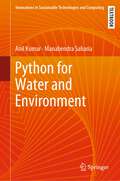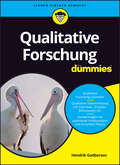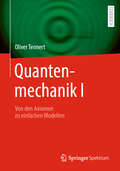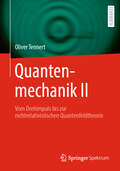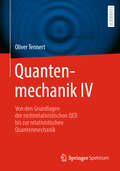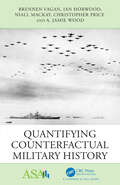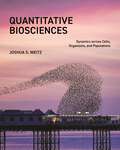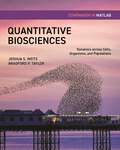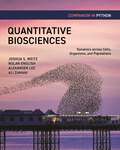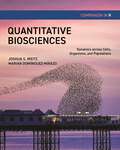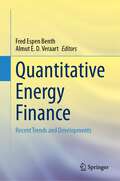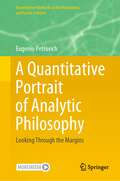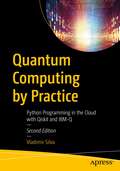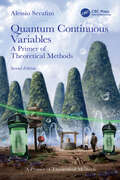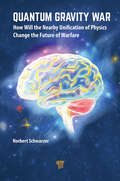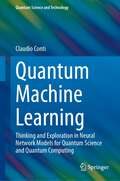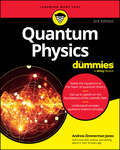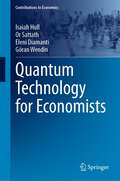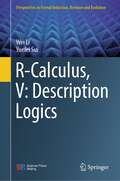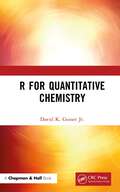- Table View
- List View
Python for Water and Environment (Innovations in Sustainable Technologies and Computing)
by Anil Kumar Manabendra SahariaThis textbook delves into the practical applications of surface and groundwater hydrology, as well as the environment. The Part I, "Practical Python for a Water and Environment Professional," guides readers through setting up a scientific computing environment and conducting exploratory data analysis and visualization using reproducible workflows. The Part II, "Statistical Modeling in Hydrology," covers regression models, time series analysis, and common hypothesis testing. The Part III, "Surface and Subsurface Water," illustrates the use of Python in understanding key concepts related to seepage, groundwater, and surface water flows. Lastly, the Part IV, "Environmental Applications," demonstrates the application of Python in the study of various contaminant transport phenomena.
Qualitative Forschung für Dummies (Für Dummies)
by Hendrik GodbersenSo werden aus Worten Daten Sie wollen bei einer Untersuchung mehr über Motive und Anliegen der zu untersuchenden Gruppe wissen? Dann helfen Ihnen die Methoden der qualitativen Forschung weiter. Hendrik Godbersen erklärt Ihnen von der Pike auf, was Sie über qualitative Forschung wissen müssen, um selbst eine Untersuchung vorzunehmen. Er erläutert dabei den qualitativen Forschungsansatz, Ziele und Designs sowie die Gütekriterien. Außerdem vermittelt er Ihnen, wie Sie Forschungsarbeiten strukturieren, Daten erheben und auswerten und zuletzt die Ergebnisse interpretieren. So wird Ihre Untersuchung gewiss ein Erfolg. Sie erfahren Wie Sie Interviews führen und Gruppendiskussionen leiten Wie Sie qualitative Daten aufzeichnen und transkribieren Wie Sie die richtige Methode für die Datenauswertung nutzen Wie Sie die Qualität Ihrer Untersuchung sichern
Quantenmechanik I: Von den Axiomen zu einfachen Modellen
by Oliver TennertIn einer umfassenden Darstellung entwickeln und vertiefen die vier Bände dieses Lehrbuchs das Gebäude der nichtrelativistischen Quantenmechanik, weshalb sie auch bestens als Nachschlagewerk geeignet sind. Der erste Band beginnt mit einer anekdotenreichen und spannenden historischen Überblicksdarstellung, die die Hauptprotagonisten der Quantentheorie und wichtige Meilensteine ihres Wirkens vorstellt. Im Folgenden wird dann die Formulierung im Hilbert-Raum axiomatisch entwickelt und wichtige Grundlagenthemen behandelt: die eindimensionalen Probleme, der harmonische Oszillator und die WKB-Näherung als Bindeglied zur klassischen Physik. Besonderheiten: Auch komplizierte Zusammenhänge werden illustrativ und klar erklärt. Zahlreiche mathematische Einschübe erläutern allgemeine mathematische Zusammenhänge. Besondere Highlights des Buches sind die frühe Entwicklung von Propagatormethoden, die ausführliche mathematische Behandlung von kohärenten und gequetschten Zuständen des harmonischen Oszillators, sowie die gründliche Untersuchung des klassischen Grenzfalls. Inhalt 1. Historischer Abriss: Der Weg zur Quantenmechanik - 2. Der theoretische Formalismus der Quantenmechanik - 3. Eindimensionale Probleme - 4. Der harmonische Oszillator in der Quantenmechanik - 5. Die WKB-Näherung und der klassische Grenzfall Zielgruppe: Das Buch richtet sich sowohl an Bachelor- als auch an Masterstudierende sowie ihre Lehrenden. Aufgrund seines mehrbändigen Charakters, der breiten Themenvielfalt und Bezügen zu wissenschaftlichen Originalarbeiten allerdings ein Muss für jedes Bücherregal einer in der Physik tätigen Person. Vorkenntnisse: Vorausgesetzt werden Kenntnisse der Theoretischen Mechanik, der Elektrodynamik und der Speziellen Relativitätstheorie, sowie der Analysis, der linearen Algebra und der Funktionentheorie.
Quantenmechanik II: Vom Drehimpuls bis zur nichtrelativistischen Quantenfeldtheorie
by Oliver TennertIn einer umfassenden Darstellung entwickeln und vertiefen die vier Bände dieses Lehrbuchs das Gebäude der nichtrelativistischen Quantenmechanik, weshalb sie auch bestens als Nachschlagewerk geeignet sind. Der zweite Band behandelt den quantenmechanischen Drehimpuls, sowie Symmetrien in der nichtrelativistischen Quantenmechanik. Anschließend wird das wichtige Anwendungsgebiet der dreidimensionalen Probleme sowohl auf algebraischem Wege als auch mit analytischen Methoden untersucht. Es schließen sich Kapitel zu Teilchen in elektromagnetischen Feldern und zum großen Themenkomplex identischer Teilchen an, welcher nahtlos zur Feldquantisierung weiterführt. Besonderheiten: Auch komplizierte Zusammenhänge werden illustrativ und klar erklärt. Zahlreiche mathematische Einschübe erläutern allgemeine mathematische Zusammenhänge. Besondere Highlights des Buches sind der algebraische Beweis zur Ganzzahligkeit des Bahndrehimpulses, die ausführliche Untersuchung des Zusammenhangs zwischen Clifford-Algebren und Spinoren, sowie ein Linearisierungsansatz für die Schrödinger-Gleichung. Die Mathematik der Eichtheorien bietet eine zusammenhängende Formulierung sehr vieler topologischer Phänomene wie magnetischer Monopole, des Aharonov–Bohm-Effekts oder von Landau-Niveaus. Inhalt 1. Theorie des Drehimpulses I - 2. Symmetrien in der Quantenmechanik I - 3. Dreidimensionale Probleme - 4. Teilchen in elektromagnetischen Feldern - 5. Theorie des Drehimpulses II - 6. Identische Teilchen und nichtrelativistische Quantenfeldtheorie Zielgruppe: Das Buch richtet sich sowohl an Bachelor- als auch an Masterstudierende sowie ihre Lehrenden. Aufgrund seines mehrbändigen Charakters, der breiten Themenvielfalt und Bezügen zu wissenschaftlichen Originalarbeiten allerdings ein Muss für jedes Bücherregal einer in der Physik tätigen Person. Vorkenntnisse: Vorausgesetzt werden Kenntnisse der Theoretischen Mechanik, der Elektrodynamik und der Speziellen Relativitätstheorie, sowie der Analysis, der linearen Algebra und der Funktionentheorie.
Quantenmechanik IV: Von den Grundlagen der nichtrelativistischen QED bis zur relativistischen Quantenmechanik
by Oliver TennertIn einer umfassenden Darstellung entwickeln und vertiefen die vier Bände dieses Lehrbuchs das Gebäude der nichtrelativistischen Quantenmechanik, weshalb sie auch bestens als Nachschlagewerk geeignet sind. Der vierte Band beginnt mit einem ausführlichen Kapitel zur nichtrelativistischen Quantenelektrodynamik (QED), traditionell als "Quantentheorie der Strahlung" bezeichnet, und leitet dann über in die relativistische Quantentheorie. Eine sorgfältige Behandlung der Möglichkeiten und Grenzen einer relativistischen Quantenmechanik sowie eine gründliche Untersuchung von Symmetrien in der relativistischen Quantentheorie schließen das Lehrbuch ab. Besonderheiten: Auch komplizierte Zusammenhänge werden illustrativ und klar erklärt. Zahlreiche mathematische Einschübe erläutern allgemeine mathematische Zusammenhänge. Besondere Highlights des Buches sind eine ausführliche Diskussionder Lamb-Verschiebung und des Casimir-Effekts, einschließlich der in diesem Zusammenhang offenbar werdenden Problematik der Renormierung, sowie die Analyse der Einteilchen-Interpretation in der relativistischen Quantenmechanik und die Betrachtung von Gruppenkontraktionen im Übergang von relativistischen zu nichtrelativistischen Symmetriegruppen und ihrer Darstellungen. Inhalt 1. Quantisierung des elektromagnetischen Feldes - 2. Relativistische Quantenmechanik - 3. Symmetrien in der Quantenmechanik II Zielgruppe: Das Buch richtet sich sowohl an Bachelor- als auch an Masterstudierende sowie ihre Lehrenden. Aufgrund seines mehrbändigen Charakters, der breiten Themenvielfalt und Bezügen zu wissenschaftlichen Originalarbeiten allerdings ein Muss für jedes Bücherregal einer in der Physik tätigen Person. Vorkenntnisse: Vorausgesetzt werden Kenntnisse der Theoretischen Mechanik, der Elektrodynamik und der Speziellen Relativitätstheorie, sowie der Analysis, der linearen Algebra und der Funktionentheorie.
Quantifying Counterfactual Military History (ASA-CRC Series on Statistical Reasoning in Science and Society)
by Brennen Fagan Ian Horwood Niall MacKay Christopher Price A. Jamie WoodForces shaping human history are complex, but the course of history is undeniably changed on many occasions by conscious acts. These may be premeditated or responsive, calmly calculated or performed under great pressure. They may also be successful or catastrophic, but how are historians to make such judgements and appeal to evidence in support of their conclusions? Further, and crucially, how exactly are we to distinguish probable unrealized alternatives from improbable ones? This book describes some of the modern statistical techniques that can begin to answer this question, as well as some of the difficulties in doing so. Using simple, wellquantified cases drawn from military history, we claim that statistics can now help us to navigate the near-truths, the envelope around the events with which any meaningful historical analysis must deal, and to quantify the basis of such analysis. Quantifying Counterfactual Military History is intended for a general audience who are interested in learning more about statistical methods both in military history and for wider applications. Key Features: This book demonstrates how modern statistical techniques can measure the impact of counterfactual decisions. It examines the importance of counterfactual reasoning for both modern scholars and historical actors. It combines historical narrative, mathematical precision and data to create a straightforward presentation of both factual and counterfactual military history. It provides an original contribution to the debate over the validity and rigour of works of counterfactual history. It is written in a manner accessible to readers who have no formal training in History or Statistics.
Quantifying Counterfactual Military History (ASA-CRC Series on Statistical Reasoning in Science and Society)
by Brennen Fagan Ian Horwood Niall MacKay Christopher Price A. Jamie WoodForces shaping human history are complex, but the course of history is undeniably changed on many occasions by conscious acts. These may be premeditated or responsive, calmly calculated or performed under great pressure. They may also be successful or catastrophic, but how are historians to make such judgements and appeal to evidence in support of their conclusions? Further, and crucially, how exactly are we to distinguish probable unrealized alternatives from improbable ones? This book describes some of the modern statistical techniques that can begin to answer this question, as well as some of the difficulties in doing so. Using simple, wellquantified cases drawn from military history, we claim that statistics can now help us to navigate the near-truths, the envelope around the events with which any meaningful historical analysis must deal, and to quantify the basis of such analysis. Quantifying Counterfactual Military History is intended for a general audience who are interested in learning more about statistical methods both in military history and for wider applications. Key Features: This book demonstrates how modern statistical techniques can measure the impact of counterfactual decisions. It examines the importance of counterfactual reasoning for both modern scholars and historical actors. It combines historical narrative, mathematical precision and data to create a straightforward presentation of both factual and counterfactual military history. It provides an original contribution to the debate over the validity and rigour of works of counterfactual history. It is written in a manner accessible to readers who have no formal training in History or Statistics.
Quantitative Biosciences: Dynamics across Cells, Organisms, and Populations
by Joshua S. WeitzA hands-on approach to quantitative reasoning in the life sciencesQuantitative Biosciences establishes the quantitative principles of how living systems work across scales, drawing on classic and modern discoveries to present a case study approach that links mechanisms, models, and measurements. Each case study is organized around a central question in the life sciences: Are mutations dependent on selection? How do cells respond to fluctuating signals in the environment? How do organisms move in flocks given local sensing? How does the size of an epidemic depend on its initial speed of spread? Each question provides the basis for introducing landmark advances in the life sciences while teaching students—whether from the life sciences, physics, computational sciences, engineering, or mathematics—how to reason quantitatively about living systems given uncertainty.Draws on real-world case studies in molecular and cellular biosciences, organismal behavior and physiology, and populations and ecological communitiesStand-alone lab guides available in Python, R, and MATLAB help students move from learning in the classroom to doing research in practiceHomework exercises build on the lab guides, emphasizing computational model development and analysis rather than pencil-and-paper derivationsSuitable for capstone undergraduate classes, foundational graduate classes, or as part of interdisciplinary courses for students from quantitative backgroundsCan be used as part of conventional, flipped, or hybrid instruction formatsAdditional materials available to instructors, including lesson plans and homework solutions
Quantitative Biosciences Companion in MATLAB: Dynamics across Cells, Organisms, and Populations
by Joshua S. Weitz Bradford TaylorA hands-on lab guide in the MATLAB programming language that enables students in the life sciences to reason quantitatively about living systems across scalesThis lab guide accompanies the textbook Quantitative Biosciences, providing students with the skills they need to translate biological principles and mathematical concepts into computational models of living systems. This hands-on guide uses a case study approach organized around central questions in the life sciences, introducing landmark advances in the field while teaching students—whether from the life sciences, physics, computational sciences, engineering, or mathematics—how to reason quantitatively in the face of uncertainty.Draws on real-world case studies in molecular and cellular biosciences, organismal behavior and physiology, and populations and ecological communitiesEncourages good coding practices, clear and understandable modeling, and accessible presentation of resultsHelps students to develop a diverse repertoire of simulation approaches, enabling them to model at the appropriate scaleBuilds practical expertise in a range of methods, including sampling from probability distributions, stochastic branching processes, continuous time modeling, Markov chains, bifurcation analysis, partial differential equations, and agent-based simulationsBridges the gap between the classroom and research discovery, helping students to think independently, troubleshoot and resolve problems, and embark on research of their ownStand-alone computational lab guides for Quantitative Biosciences also available in Python and R
Quantitative Biosciences Companion in Python: Dynamics across Cells, Organisms, and Populations
by Joshua S. Weitz Nolan English Alexander B. Lee Ali ZamaniA hands-on lab guide in the Python programming language that enables students in the life sciences to reason quantitatively about living systems across scalesThis lab guide accompanies the textbook Quantitative Biosciences, providing students with the skills they need to translate biological principles and mathematical concepts into computational models of living systems. This hands-on guide uses a case study approach organized around central questions in the life sciences, introducing landmark advances in the field while teaching students—whether from the life sciences, physics, computational sciences, engineering, or mathematics—how to reason quantitatively in the face of uncertainty.Draws on real-world case studies in molecular and cellular biosciences, organismal behavior and physiology, and populations and ecological communitiesEncourages good coding practices, clear and understandable modeling, and accessible presentation of resultsHelps students to develop a diverse repertoire of simulation approaches, enabling them to model at the appropriate scaleBuilds practical expertise in a range of methods, including sampling from probability distributions, stochastic branching processes, continuous time modeling, Markov chains, bifurcation analysis, partial differential equations, and agent-based simulationsBridges the gap between the classroom and research discovery, helping students to think independently, troubleshoot and resolve problems, and embark on research of their ownStand-alone computational lab guides for Quantitative Biosciences also available in R and MATLAB
Quantitative Biosciences Companion in R: Dynamics across Cells, Organisms, and Populations
by Joshua S. Weitz Marian Domínguez-MirazoA hands-on lab guide in the R programming language that enables students in the life sciences to reason quantitatively about living systems across scalesThis lab guide accompanies the textbook Quantitative Biosciences, providing students with the skills they need to translate biological principles and mathematical concepts into computational models of living systems. This hands-on guide uses a case study approach organized around central questions in the life sciences, introducing landmark advances in the field while teaching students—whether from the life sciences, physics, computational sciences, engineering, or mathematics—how to reason quantitatively in the face of uncertainty.Draws on real-world case studies in molecular and cellular biosciences, organismal behavior and physiology, and populations and ecological communitiesEncourages good coding practices, clear and understandable modeling, and accessible presentation of resultsHelps students to develop a diverse repertoire of simulation approaches, enabling them to model at the appropriate scaleBuilds practical expertise in a range of methods, including sampling from probability distributions, stochastic branching processes, continuous time modeling, Markov chains, bifurcation analysis, partial differential equations, and agent-based simulationsBridges the gap between the classroom and research discovery, helping students to think independently, troubleshoot and resolve problems, and embark on research of their ownStand-alone computational lab guides for Quantitative Biosciences also available in Python and MATLAB
Quantitative Energy Finance: Recent Trends and Developments
by Fred Espen Benth Almut E. D. VeraartPower markets are undergoing a major transformation from gas and oil-fueled generation toward renewable electricity production from wind and solar sources. Simultaneously, there is an increasing demand for electrification, coupled with long-term climate-induced weather changes. The uncertainties confronting energy market participants require sophisticated modelling techniques to effectively understand risk, many of which are covered in this book.Comprising invited papers by high-profile researchers, this volume examines the empirical aspects of forward and futures prices, uncovering patterns of noise factors in various European electricity markets. Additionally, it delves into the recent, influential classes of Hawkes and trawl processes, emphasizing their significance in energy markets. The impact of renewables on energy market prices is a pivotal concern for both producers and consumers. Mean-field games provide a powerful mathematical framework for this, and a dedicated chapter outlining their dynamics is included in the book. The book also explores structural financial products and their connection to climate risk as a risk management tool, underscoring the essential need for a comprehensive understanding of these products in the realm of "green finance," to which the energy industry is integral. Lastly, the book thoroughly analyzes spatial smoothing and power purchase (PPA) contracts, addressing central issues in energy system planning and financial operations.Tailored for researchers, PhD students, and industry energy analysts, this volume equips readers with insights and tools to navigate the constantly evolving energy market landscape. It serves as a sequel to the earlier Quantitative Energy Finance book, featuring all-new chapters.
A Quantitative Portrait of Analytic Philosophy: Looking Through the Margins (Quantitative Methods in the Humanities and Social Sciences)
by Eugenio PetrovichThis book offers an unprecedented quantitative portrait of analytic philosophy focusing on two seemingly marginal features of philosophical texts: citations and acknowledgements in academic publications. Originating from a little network of philosophers based in Oxford, Cambridge, and Vienna, analytic philosophy has become during the Twentieth century a thriving philosophical community with thousands of members worldwide. Leveraging the most advanced techniques from bibliometrics, citations and acknowledgments are used in this book to shed light on both the epistemology and the sociology of this philosophical field, illuminating the intellectual trajectory of analytic philosophy as well as the social characteristics of the analytic community. Special attention is dedicated to the last forty years, providing insights into a phase of analytic philosophy which is still understudied by historians of philosophy. In the eight chapters of the book, readers will find not only numerous quantitative investigations and technical explanations, but also a robust theoretical framework and epistemological reflections on the strengths and limitations of quantitative methods for the study of philosophy. With its strong interdisciplinary appeal, this book will engage a wide range of scholars, including historians of philosophy seeking new methodologies, analytic philosophers interested in a new look at their discipline, and scholars in digital humanities, bibliometrics, and quantitative studies of science, who will find many innovative techniques for investigating disciplinary fields.
Quantum Computing by Practice: Python Programming in the Cloud with Qiskit and IBM-Q
by Vladimir SilvaLearn to write algorithms and program in the new field of quantum computing. This second edition is updated to equip you with the latest knowledge and tools needed to be a complex problem-solver in this ever-evolving landscape. The book has expanded its coverage of current and future advancements and investments by IT companies in this emerging technology. Most chapters are thoroughly revised to incorporate the latest updates to IBM Quantum's systems and offerings, such as improved algorithms, integrating hardware advancements, software enhancements, bug fixes, and more. You’ll examine quantum computing in the cloud and run experiments there on a real quantum device. Along the way you’ll cover game theory with the Magic Square, an example of quantum pseudo-telepathy. You’ll also learn to write code using QISKit, Python SDK, and other APIs such as QASM and execute it against simulators (local or remote) or a real quantum computer. Then peek inside the inner workings of the Bell states for entanglement, Grover’s algorithm for linear search, Shor’s algorithm for integer factorization, and other algorithms in the fields of optimization, and more. Finally, you’ll learn the current quantum algorithms for entanglement, random number generation, linear search, integer factorization, and others. By the end of this book, you’ll understand how quantum computing provides massive parallelism and significant computational speedups over classical computersWhat You'll LearnWrite algorithms that provide superior performance over their classical counterpartsCreate a quantum number generator: the quintessential coin flip with a quantum twistExamine the quantum algorithms in use today for random number generation, linear search, and moreDiscover quantum teleportationHandle the counterfeit coin problem, a classic puzzle Put your knowledge to the test with more than 150 practice exercises Who This Book Is ForDevelopers, programmers, computer science researchers, teachers, and students.
Quantum Continuous Variables: A Primer of Theoretical Methods
by Alessio SerafiniQuantum Continuous Variables introduces the theory of continuous variable quantum systems, from its foundations based on the framework of Gaussian states to modern developments, including its applications to quantum information and forthcoming quantum technologies. This book addresses the theory of Gaussian states, operations, and dynamics in great depth and breadth, through a novel approach that embraces both the Hilbert space and phase descriptions.The second edition of this book has been revised throughout, and updated to include new topics, such as boson sampling, coherent feedback, nonlinear control, as well as several new solved problems.The volume includes coverage of entanglement theory and quantum information protocols, and their connection with relevant experimental set-ups. General techniques for non-Gaussian manipulations also emerge as the treatment unfolds and are demonstrated with specific case studies.This book will be of interest to graduate students looking to familiarise themselves with the field, in addition to experienced researchers eager to enhance their understanding of its theoretical methods. It will also appeal to experimentalists searching for a rigorous but accessible treatment of the theory in the area.Features Provides the first systematic graduate-level textbook for the field of quantum continuous variables and includes 77 problems for the reader, with accompanying solutions Explores applications to entanglement theory, nonlocality, quantum technologies and quantum control Describes, in detail, a comprehensive list of experimental platforms where the formalism applies Alessio Serafini earned his PhD from the University of Salerno. He is currently a Professor at University College London. His research focuses mainly on quantum optics, quantum information with continuous variables, and the theory of quantum control.
Quantum Continuous Variables: A Primer of Theoretical Methods
by Alessio SerafiniQuantum Continuous Variables introduces the theory of continuous variable quantum systems, from its foundations based on the framework of Gaussian states to modern developments, including its applications to quantum information and forthcoming quantum technologies. This book addresses the theory of Gaussian states, operations, and dynamics in great depth and breadth, through a novel approach that embraces both the Hilbert space and phase descriptions.The second edition of this book has been revised throughout, and updated to include new topics, such as boson sampling, coherent feedback, nonlinear control, as well as several new solved problems.The volume includes coverage of entanglement theory and quantum information protocols, and their connection with relevant experimental set-ups. General techniques for non-Gaussian manipulations also emerge as the treatment unfolds and are demonstrated with specific case studies.This book will be of interest to graduate students looking to familiarise themselves with the field, in addition to experienced researchers eager to enhance their understanding of its theoretical methods. It will also appeal to experimentalists searching for a rigorous but accessible treatment of the theory in the area.Features Provides the first systematic graduate-level textbook for the field of quantum continuous variables and includes 77 problems for the reader, with accompanying solutions Explores applications to entanglement theory, nonlocality, quantum technologies and quantum control Describes, in detail, a comprehensive list of experimental platforms where the formalism applies Alessio Serafini earned his PhD from the University of Salerno. He is currently a Professor at University College London. His research focuses mainly on quantum optics, quantum information with continuous variables, and the theory of quantum control.
Quantum Gravity War: How Will the Nearby Unification of Physics Change the Future of Warfare
by Norbert SchwarzerImagine a civilization with a technology so powerful that a single push of the “wrong” button could destroy this very entire civilization. As the consideration of future warfare requires the inclusion of a unified physics, we have to deal with complex concepts of Quantum Theory and General Theory of Relativity. The two have to be brought together before we are able to deal with the matter of future warfare technology in a satisfactory manner. That such a “Theory of Everything” or “Theory of Quantum Gravity”—in principle—already exists and had been already derived by the great German mathematician David Hilbert. When digging deeper and looking for applications of the “new” theory, we realized that many of the new possibilities could also lead to quite disastrous utilizations in military. It is futile to hope that mankind would not recognize this potential and restrain itself from its exploitation.Thus, we thought we better make this knowledge public and hope for some kind of global understanding, perhaps guaranteeing the non-usage of certain technologies. It might only be a weak hope, but in observing history and realizing how little we gained by keeping crucial knowledge restricted to some, thereby often only even more provoking the development of the most horrific weapons one could imagine at the time, we simply see no better way. This book does not provide blueprints ready to start the developments of new quantum gravity weaponry and strategies, but it draws the line that would suffice to awake the right forces and trigger the best developments … before the bad guys get the gist.
Quantum Gravity War: How Will the Nearby Unification of Physics Change the Future of Warfare
by Norbert SchwarzerImagine a civilization with a technology so powerful that a single push of the “wrong” button could destroy this very entire civilization. As the consideration of future warfare requires the inclusion of a unified physics, we have to deal with complex concepts of Quantum Theory and General Theory of Relativity. The two have to be brought together before we are able to deal with the matter of future warfare technology in a satisfactory manner. That such a “Theory of Everything” or “Theory of Quantum Gravity”—in principle—already exists and had been already derived by the great German mathematician David Hilbert. When digging deeper and looking for applications of the “new” theory, we realized that many of the new possibilities could also lead to quite disastrous utilizations in military. It is futile to hope that mankind would not recognize this potential and restrain itself from its exploitation.Thus, we thought we better make this knowledge public and hope for some kind of global understanding, perhaps guaranteeing the non-usage of certain technologies. It might only be a weak hope, but in observing history and realizing how little we gained by keeping crucial knowledge restricted to some, thereby often only even more provoking the development of the most horrific weapons one could imagine at the time, we simply see no better way. This book does not provide blueprints ready to start the developments of new quantum gravity weaponry and strategies, but it draws the line that would suffice to awake the right forces and trigger the best developments … before the bad guys get the gist.
Quantum Machine Learning: Thinking and Exploration in Neural Network Models for Quantum Science and Quantum Computing (Quantum Science and Technology)
by Claudio ContiThis book presents a new way of thinking about quantum mechanics and machine learning by merging the two. Quantum mechanics and machine learning may seem theoretically disparate, but their link becomes clear through the density matrix operator which can be readily approximated by neural network models, permitting a formulation of quantum physics in which physical observables can be computed via neural networks. As well as demonstrating the natural affinity of quantum physics and machine learning, this viewpoint opens rich possibilities in terms of computation, efficient hardware, and scalability. One can also obtain trainable models to optimize applications and fine-tune theories, such as approximation of the ground state in many body systems, and boosting quantum circuits’ performance. The book begins with the introduction of programming tools and basic concepts of machine learning, with necessary background material from quantum mechanics and quantum information also provided. This enables the basic building blocks, neural network models for vacuum states, to be introduced. The highlights that follow include: non-classical state representations, with squeezers and beam splitters used to implement the primary layers for quantum computing; boson sampling with neural network models; an overview of available quantum computing platforms, their models, and their programming; and neural network models as a variational ansatz for many-body Hamiltonian ground states with applications to Ising machines and solitons. The book emphasizes coding, with many open source examples in Python and TensorFlow, while MATLAB and Mathematica routines clarify and validate proofs. This book is essential reading for graduate students and researchers who want to develop both the requisite physics and coding knowledge to understand the rich interplay of quantum mechanics and machine learning.
Quantum Physics For Dummies
by Andrew Zimmerman JonesThe plain-English guide to understanding quantum physics Mastering quantum physics is no easy feat, but with the help of Quantum Physics For Dummies you can work at your own pace to unlock key concepts and fascinating facts. Packed with invaluable explanations, equations, and step-by-step instructions, this book makes a challenging subject much more accessible. Great for college students taking a quantum physics course, Quantum Physics For Dummies offers complete coverage of the subject, along with numerous examples to help you tackle the tough stuff. The Schrodinger Equation, the foundations of quantum physics, vector notation, scattering theory, angular momentum—it’s all in here. This handy guide helps you prepare for exams and succeed at learning quantum physics. Get clear explanations of the core concepts in quantum physics Review the math principles needed for quantum physics equations Learn the latest breakthroughs and research in the field Clarify difficult subjects and equations from your college courseQuantum Physics For Dummies is great a resource for students who need a supplement to the textbook to help them tackle this challenging subject.
Quantum Physics For Dummies
by Andrew Zimmerman JonesThe plain-English guide to understanding quantum physics Mastering quantum physics is no easy feat, but with the help of Quantum Physics For Dummies you can work at your own pace to unlock key concepts and fascinating facts. Packed with invaluable explanations, equations, and step-by-step instructions, this book makes a challenging subject much more accessible. Great for college students taking a quantum physics course, Quantum Physics For Dummies offers complete coverage of the subject, along with numerous examples to help you tackle the tough stuff. The Schrodinger Equation, the foundations of quantum physics, vector notation, scattering theory, angular momentum—it’s all in here. This handy guide helps you prepare for exams and succeed at learning quantum physics. Get clear explanations of the core concepts in quantum physics Review the math principles needed for quantum physics equations Learn the latest breakthroughs and research in the field Clarify difficult subjects and equations from your college courseQuantum Physics For Dummies is great a resource for students who need a supplement to the textbook to help them tackle this challenging subject.
Quantum Technology for Economists (Contributions to Economics)
by Isaiah Hull Or Sattath Eleni Diamanti Göran WendinThis book offers an introduction to quantum technology that is specifically tailored to economists, students of economics, and professionals in the financial and payments industries. The book reviews quantum speedups that have been identified for algorithms used to solve and estimate economic models, including function approximation, linear systems analysis, graphical modeling, Monte Carlo simulation, matrix inversion, principal component analysis, linear regression, dynamic programming, interpolation, numerical differentiation, and true random number generation. It also provides an overview of quantum financial technology and its potential applications in economics and finance. Written by an interdisciplinary team with backgrounds in economics, computer science, and physics, this book offers a valuable guide for researchers and practitioners who want to understand the implications and possibilities of quantum technology for the field of economics.
R-Calculus, V: Description Logics (Perspectives in Formal Induction, Revision and Evolution)
by Wei Li Yuefei SuiThis book series consists of two parts, decidable description logics and undecidable description logics. It gives the R-calculi for description logics. This book offers a rich blend of theory and practice. It is suitable for students, researchers and practitioners in the field of logic.
R for Quantitative Chemistry
by David K. GosserR for Quantitative Chemistry is an exploration of how the R language can be applied to a wide variety of problems in what is typically termed "Quantitative Chemistry" or sometimes "Analytical Chemistry". Topics include: basic statistics, spectroscopic data, acid base equilibria and titrations, binding curves (of great current interest for biomedical applications), Fourier Transforms, and chemical kinetics and enzyme kinetics. An innovative feature is the discussion (as an alternative to the less stable nls packages) of the simplex adaptation subplex (R package) coupled with Monte Carlo analysis to determine confidence intervals for estimated parameters resulting from least squares optimization. Chemists who are interested in learning R as a research tool as well as Chemists who are teaching Quantitative Chemistry, as well as their students will be interested. This book is useful as most R books approach data analysis from an economic, social, medical, or biological context. Analysis of chemical data draws upon specific numerical models and a different set R programming and packages than is typically discussed in other disciplines. This book will be based upon, in large part, actual experimental data and will include end of chapter questions and projects. Readers are encouraged to email the author at gosserch@gmail.com and to follow the accompanying blog on Medium "R Programming for Quantitative Chemistry". Key Features: Elements of R programming for Chemists Literature Based Examples Includes Binding Assay Analysis Integrates theory, experiment, and R programming
R for Quantitative Chemistry
by David K. GosserR for Quantitative Chemistry is an exploration of how the R language can be applied to a wide variety of problems in what is typically termed "Quantitative Chemistry" or sometimes "Analytical Chemistry". Topics include: basic statistics, spectroscopic data, acid base equilibria and titrations, binding curves (of great current interest for biomedical applications), Fourier Transforms, and chemical kinetics and enzyme kinetics. An innovative feature is the discussion (as an alternative to the less stable nls packages) of the simplex adaptation subplex (R package) coupled with Monte Carlo analysis to determine confidence intervals for estimated parameters resulting from least squares optimization. Chemists who are interested in learning R as a research tool as well as Chemists who are teaching Quantitative Chemistry, as well as their students will be interested. This book is useful as most R books approach data analysis from an economic, social, medical, or biological context. Analysis of chemical data draws upon specific numerical models and a different set R programming and packages than is typically discussed in other disciplines. This book will be based upon, in large part, actual experimental data and will include end of chapter questions and projects. Readers are encouraged to email the author at gosserch@gmail.com and to follow the accompanying blog on Medium "R Programming for Quantitative Chemistry". Key Features: Elements of R programming for Chemists Literature Based Examples Includes Binding Assay Analysis Integrates theory, experiment, and R programming
